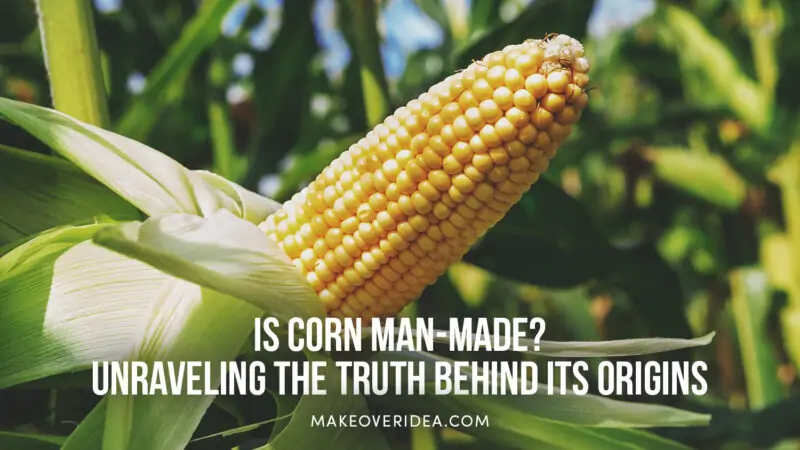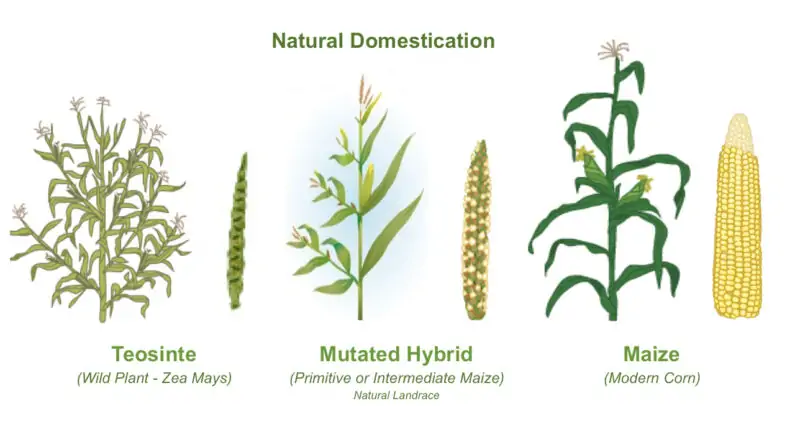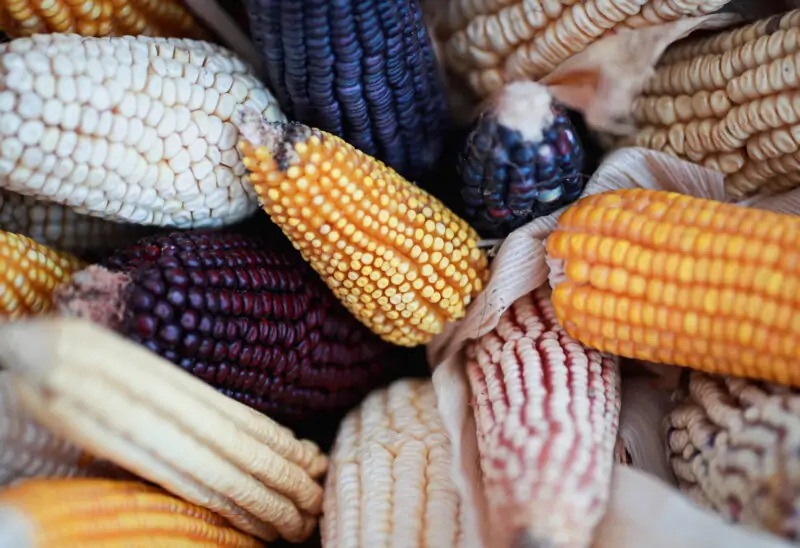Is Corn Man Made or Exists Naturally: Learn the Truth

Is corn man made? This question has puzzled many people over the years. Corn, also known as maize, is one of the world’s most widely cultivated crops and has been a staple food for thousands of years. But where did it come from? Was it always here, or was it created by humans through selective breeding techniques?
In this article, we’ll explore the origins of corn and its wild ancestor, teosinte. We’ll also delve into how ancient civilizations transformed corn through selective breeding to create modern corn varieties with different colors, sizes, and tastes.
We’ll also address some common myths about genetically modified (GMO) corn and its safety for human consumption while examining human intervention in developing new strains.
So let’s get started!
Is Corn Man-Made or Naturally Occurring?
Corn is both natural and man-made. The history behind this versatile crop goes back thousands of years when Native Americans first began cultivating an edible grass called teosinte. A member of the Zea genus, teosinte, or first corn, eventually evolved into what we know today as field or dent corn.
So, the quick answer is that corn does not exist naturally in the wild: it is a purely man-made plant.
The History of Corn and Its Wild Ancestor
The earliest evidence suggests that indigenous peoples have been breeding teosinte and then maize for at least 9,000 years before the common era (BCE). It originated from Central America but quickly spread throughout North America due to trade relations between tribes on either side of what would later become the Canada-US border.
Maize has quickly become an essential crop among various communities across North American cultures, like the Mayans, who used every part, including leaves, not just bright yellow kernels alone! They believed their gods had given them life through maize, so they respected each plant deeply.
However, despite being highly valued during precolonial times, there were still periods when droughts affected the availability of this staple crop, disrupted traditional agricultural practices, and caused famine-like conditions amongst Indigenous Nations.
Teosinte: The Wild Grass That Started It All

Teosinte plant is the wild ancestor of modern-day corn. It’s a grass that looks nothing like the sweet yellow kernels we know today but rather has small and hard seeds that are not very palatable to humans.
Teosinte was first domesticated by indigenous peoples in Mexico about 9,000 years ago. They selectively bred this food source over time to create larger and more edible seeds until it eventually evolved into what is called modern-day maize or field corn in its current form.
Selective Breeding and the Evolution of Corn
Selective breeding played a significant role in shaping modern varieties of corn as different civilizations cultivated their own strains based on specific tastes, colors, sizes, or other desired characteristics, such as drought resistance.
How Ancient Civilizations Transformed Corn
Civilizations such as the Mayans helped shape this crop through selective breeding techniques, selecting favorable traits that improved yield quality while reducing susceptibility to pests and diseases.
They were able to produce an abundant amount with less land required because they could tailor each variety according to needs, whether it be large ears of corn or smaller ones for roasting and grinding down into meals or flour.
Mayan farmers also grew multiple types, including white, red, yellow, blue, black, purple, striped, and even multicolored ornamental corn varieties!
Other civilizations followed suit, using selective breeding techniques to create new hybridized versions from two distinct plants themselves, resulting in unique hybrids made entirely through their efforts alone!
Modern Corn And Its Many Varieties
Today there are many different varieties of corn plant available, both commercially grown crops (field) and ornamental decorative purposes (Indian/Maize). Some examples include sweet corn, baby corn, popcorn, flint, dent, and waxy corn, each having its nutritional value, taste, texture, color, and size.
Modern farming practices have led us towards monoculture systems applied for corn grown in the United States and Europe. Monoculture systems mean that only one type is planted at once, making it vulnerable if a pest or disease ever attacks. It is for this reason that farmers these days strongly rely on pesticides and fertilizers.

Debunking Myths: GMO Corn And Its Safety
Genetically modified organisms have become increasingly common in agriculture, and corn is no exception. However, there are many myths surrounding GMO corn species and their safety for human consumption.
What Is GMO Corn And Is It Safe To Eat?
GMO stands for genetically modified organisms. This means that the DNA of the plant has been altered to create a new strain with desired traits such as pest resistance or increased yield.
While some people worry about eating genetically modified foods due to potential health risks, studies have shown time and again that they pose a no greater risk than non-GM crops!
The FDA (Food & Drug Administration) requires thorough testing before any GM crop can be approved for commercialization, ensuring its safe consumption by humans and animals alike!
The Role Of Human Intervention In Corn’s Development
Humans have played an essential role in shaping modern varieties of corn through selective breeding techniques, which led us towards hybridized versions over time. As a result, these days there are numerous types of corn grown in the fields, and evolution of modern varieties of this food staple continues.
With advances made possible by science today, we’ve seen revolutionary changes within agricultural practices, leading us towards higher yields and better quality food production overall.
FAQs
Corn is both natural and man-made. Its wild ancestor, teosinte, was first domesticated thousands of years ago by indigenous peoples who selectively bred it over time into what we know today as field or dent corn. It is this domesticated variety of corn we all know that began to spread worldwide.
Selective breeding involves choosing plants with desirable traits such as larger kernels, different colors or tastes, etc., then cross-pollinating them until those characteristics become more prominent across generations, resulting in hybrids, or new species of corn.
No; maize cannot grow naturally without human intervention since it’s highly dependent on specific climate conditions, soil types, and water availability. So, corn today depends on humans – just like humans depend on corn seeds.
Yes; some strains are commercially available, created using genetic engineering methods, altering their DNA to help improve certain features like drought resistance, insect tolerance, and increased yields, among others.
Yes; genetically modified corn is safe to eat according to FDA regulations after thorough testing, ensuring human and animal consumption poses a no greater risk than non-GMO crops.
There are many different varieties of corn available today, each having its nutritional value, taste, texture, color, and size. Some examples include sweet corn, baby corn, popcorn, flint, dent, and waxy corn, among others. This important food is used both for animal feeding and as food for people.
Baby corn is a miniature version of regular field or dent maize, harvested before it matures into full-sized kernels. Baby corn is used in Asian cuisine as an ingredient for salads, stir-fries, etc.
Sweet corn originated from naturally occurring mutations within normal maize, resulting in sweeter-tasting kernels, making them more palatable to humans since they don’t have a tough outer layer like the hard shells of typical field/dent types.
Conclusion
So, is corn man made? The answer depends on how you define this term. Humans played a significant role in shaping modern varieties through selective breeding techniques over thousands of years, so corn is man-made if you use this definition. Still, the wild ancestor of corn kernels, teosinte, was natural and evolved without our intervention.
GMOs also play a part in modern agriculture practices but pose no higher risks to health safety compared with their non-GM counterparts. With agricultural advancements made possible by science today, we’ve seen revolutionary changes leading us towards better quality food production overall while respecting Mother Nature at the same time!